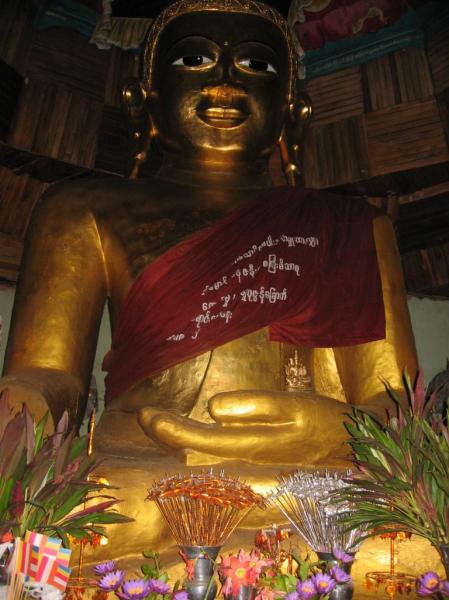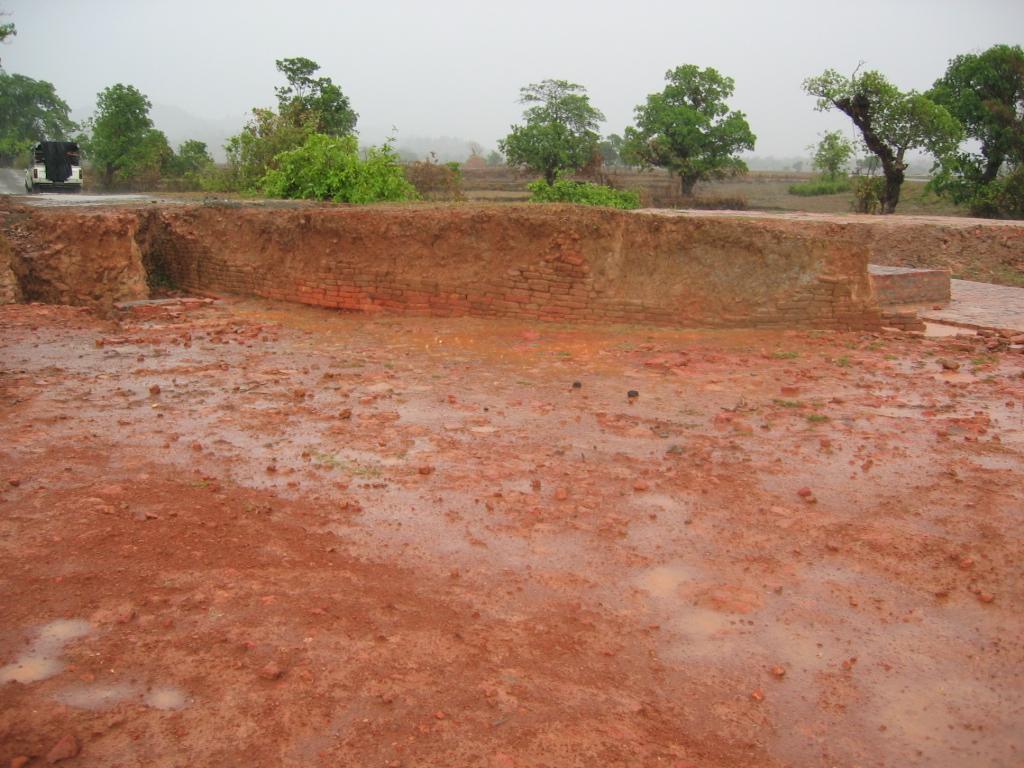Vesali described by the chronicles

The annals of the great cities in Rakhine history, the story and glory of Vesali has been well recorded. This great city lies about five miles north of Mrauk-U.
The city of Vesali was strategic sea-port in trade between India and central Myanmar. In Ananda Candra Stone Inscriptions inscribed in eight century A.D. of Vesali period, it is beautifully coined that "King Dven Candra founded the city that ridiculed the beauty of 'abode of celestial beings' (nat-pray) commemorating victory over one hundred and one kings."

Map of Vesali
Twenty successive kings ruled the kingdom from this city spanning from fourth to eight century A.D. For trade currency purposes, five sizes of gold and silver coins were used in the coins used earlier bore the titles of the ruling monarchs. As flourished in Vesali, pagodas were built, images of Lord Buddha sculpted, monasteries constructed and donated, and the use of Sanskrit became common and later used the official language.
Entering the area of old city from the south, one will first come across "Aboung-daw" lake. Close to it is Thun-kyat-taw pagoda atop 510-foot high hill. From the platform of the pagoda one can enjoy the bird's eye view of old Vesali city site.
The city wall s of Vesali are actually the palace city walls. In the compound of the palace city now locates Pi-pun-runn village. In it's centre, the site of the Palace, now lies the Vesali village on the Palace Heights. One can witness the broken bricks and other pieces scattered all around there.

Half a mile north of the Palace Heights is the 17-foot high Vesali Buddha Image sculpted out of a boulder in 327 A.D., the year of founding the city. To the east of the image lies the 70-foot high Hill where Buddhist Synod took place in Vesali period. During the Vesali period, King Thiri Dhamma Wizaya sponsored the Buddhist Synod holding celebrations on this hill in 638 A.D. participating 1000 Bhikkhus from Sri Lanka and 1000 Bhikkhus from Vesali Rakhine Kingdom.
West of the Palace Heights is the Stone-stairs (jetty) of the port. With reference to these stone-stairs, the city was named Vesali, the Stone-stairs City".
The excavation of this old city was started in the year 1980 by the Myanmar Archaeology Department. On excavating Hill No. (1), the ruined religious structures, Hill No.(2), a ruined building measuring 70 feet and 50 feet in length and breath respectively, Hill No.(3), part of the buttocks of an ox in the crouching position made of stone were discovered and transferred to Mrauk-U museum.
On excavating Hill No(4), part of the city wall and sandstone inscriptions bearing Sansrit scripts, and Hill No(5), interior rooms of a building with measurements of 74 feet and 50 feet in length and breadth respectively and also an ordination hall with a stone plate used as the pillar in consecrating the ground were discovered. The ordination hall uncovered at Hill No.(5) is the most ancient type of its kind.
On the bank of Thari-chaung creek west of Vesali city is "Shun Kyaw" Buddha Image. This Image is famous next to Mahamuni Image in olden days. As the original Image was brought to Amarapura, the present Image casted in 1924 A.D. for substitution.

Vesali Palace Heights
The Vesali city walls covers an area of 2.7 square miles. The walls of Vesali are that of Palace City at the centre of which lies the Palace Heights. At present, the Vesali village is located on the site and that the walls of Vesali can still be seen vividly.
When Hill No.(3) of Vesali was unearthed part of the buttocks of an ox in crouching position made of stone was found out. Now, it has been exhibited at Mrauk-U museum. At Hill No. (5), the interior rooms of a building measuring 74 feet in lengths and 50 feet in breadth and stone plates used in consecrating the gound to erect the ordination hall were unearthed.
Credit:
Aung, Myar. Famous Monuments of Mrauk-U (Useful Reference for Tourists and Travelers). (2nd ed.). Yango

The annals of the great cities in Rakhine history, the story and glory of Vesali has been well recorded. This great city lies about five miles north of Mrauk-U.
The city of Vesali was strategic sea-port in trade between India and central Myanmar. In Ananda Candra Stone Inscriptions inscribed in eight century A.D. of Vesali period, it is beautifully coined that "King Dven Candra founded the city that ridiculed the beauty of 'abode of celestial beings' (nat-pray) commemorating victory over one hundred and one kings."

Map of Vesali
Twenty successive kings ruled the kingdom from this city spanning from fourth to eight century A.D. For trade currency purposes, five sizes of gold and silver coins were used in the coins used earlier bore the titles of the ruling monarchs. As flourished in Vesali, pagodas were built, images of Lord Buddha sculpted, monasteries constructed and donated, and the use of Sanskrit became common and later used the official language.
Entering the area of old city from the south, one will first come across "Aboung-daw" lake. Close to it is Thun-kyat-taw pagoda atop 510-foot high hill. From the platform of the pagoda one can enjoy the bird's eye view of old Vesali city site.
The city wall s of Vesali are actually the palace city walls. In the compound of the palace city now locates Pi-pun-runn village. In it's centre, the site of the Palace, now lies the Vesali village on the Palace Heights. One can witness the broken bricks and other pieces scattered all around there.

Half a mile north of the Palace Heights is the 17-foot high Vesali Buddha Image sculpted out of a boulder in 327 A.D., the year of founding the city. To the east of the image lies the 70-foot high Hill where Buddhist Synod took place in Vesali period. During the Vesali period, King Thiri Dhamma Wizaya sponsored the Buddhist Synod holding celebrations on this hill in 638 A.D. participating 1000 Bhikkhus from Sri Lanka and 1000 Bhikkhus from Vesali Rakhine Kingdom.
West of the Palace Heights is the Stone-stairs (jetty) of the port. With reference to these stone-stairs, the city was named Vesali, the Stone-stairs City".
The excavation of this old city was started in the year 1980 by the Myanmar Archaeology Department. On excavating Hill No. (1), the ruined religious structures, Hill No.(2), a ruined building measuring 70 feet and 50 feet in length and breath respectively, Hill No.(3), part of the buttocks of an ox in the crouching position made of stone were discovered and transferred to Mrauk-U museum.
On excavating Hill No(4), part of the city wall and sandstone inscriptions bearing Sansrit scripts, and Hill No(5), interior rooms of a building with measurements of 74 feet and 50 feet in length and breadth respectively and also an ordination hall with a stone plate used as the pillar in consecrating the ground were discovered. The ordination hall uncovered at Hill No.(5) is the most ancient type of its kind.
On the bank of Thari-chaung creek west of Vesali city is "Shun Kyaw" Buddha Image. This Image is famous next to Mahamuni Image in olden days. As the original Image was brought to Amarapura, the present Image casted in 1924 A.D. for substitution.

Vesali Palace Heights
The Vesali city walls covers an area of 2.7 square miles. The walls of Vesali are that of Palace City at the centre of which lies the Palace Heights. At present, the Vesali village is located on the site and that the walls of Vesali can still be seen vividly.
When Hill No.(3) of Vesali was unearthed part of the buttocks of an ox in crouching position made of stone was found out. Now, it has been exhibited at Mrauk-U museum. At Hill No. (5), the interior rooms of a building measuring 74 feet in lengths and 50 feet in breadth and stone plates used in consecrating the gound to erect the ordination hall were unearthed.
Credit:
Aung, Myar. Famous Monuments of Mrauk-U (Useful Reference for Tourists and Travelers). (2nd ed.). Yango

Comments